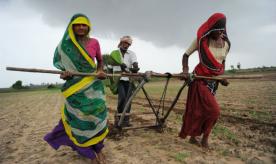Women and work in rural India
- In contrast with global trends, India has witnessed a decline in women’s employment rates over the past few decades.
- We investigated this decline in rural areas, where the majority of Indian women live.
- We found that increasing education levels among rural married women and the men in their households were the most important factors contributing to the decline in female labour force participation.
- Women with higher levels of education are spending more time on domestic work and childcare. This may be because there are greater returns to domestic work than to market work for women with medium levels of education.
Contrary to global trends, the proportion of Indian women in work has been declining since the 1980s, despite lower fertility rates and higher female educational attainment. We used three rounds of Indian National Sample Surveys from 1987 to 2011 to show that low rates of female labour force participation are concentrated among married women working in rural areas.
We found that changes in observed demographic and socioeconomic attributes fully account for the fall in the female labour force participation rate in the 1987-1999 period, but explain only half of the decrease for 1999-2001. Demographic attributes include women’s educational level, while socioeconomic attributes include household income and men’s educational level, all of which have increased over the last 30 years. We found that women’s education was the most important observed factor contributing to decline in the proportion of women working for both periods.
This is due to the role of women in home production. We found that more educated women are spending more time in domestic work and childcare. Women’s decisions about working in the market or at home depend on the relative returns to time spent in each sector. We found suggestive evidence that for women with medium levels of education the returns to domestic work are higher than the returns to market work. This may be an important factor in explaining the long-term trend of the declining women’s labour force participation rate in rural India.
To increase the returns to market work, policy should aim to bolster the demand for women's labour through manufacturing sector growth, and providing women easier access to work opportunities (such as flexible working hours) and better child care services.






